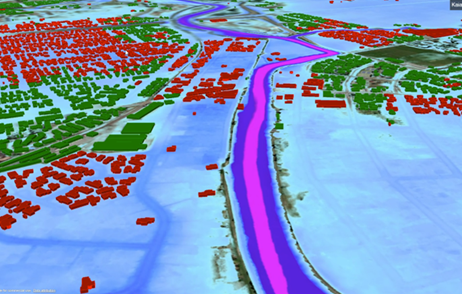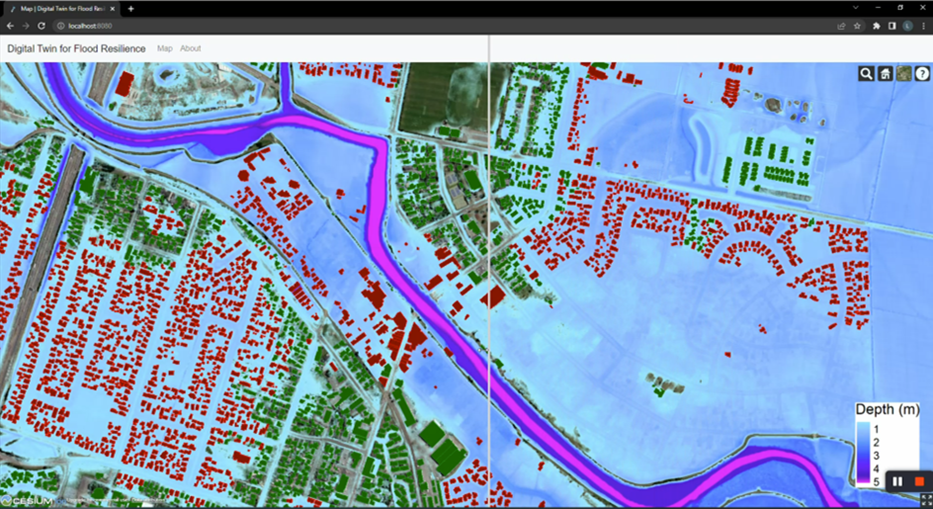Project Team GRI
Luke Parkinson (Software developer)
Casey Li (Software developer)
Pooja Kholsa (Software developer)
Matt Wilson (PI)
Wider Team
Greg Preston (BIP)
Rose Pearson
Cyprien Bosserelle (NIWA)
Emily Lane (NIWA)
Rob Deakin (LINZ)
Project summary
This project aims to create a “digital twin” prototype as a proof-of-concept system to assist with more efficient flood risk management. Flood inundation is a frequent and impactful hazard that can cause significant damage to infrastructure, housing, and communities. This technology creates a digital representation of an entity such as a building, city or region, and provides real-time data from sensors for analysis and prediction.
The digital twin aims to address the challenges faced by flood risk managers in processing large amounts of spatial data related to infrastructure and the environment, which can be challenging during natural disasters when quick decision-making is crucial. The problem right now is that the vast amount of data we have makes it an enormous task to process it all in a timely way, if we leave it to individuals or small teams to try and pull it together to make quick decisions.
The technology can overcome this barrier and improve official responses to natural disasters. Moreover, to manage an expected increase in future flood risk, efficient scenario assessment for flood risk management is essential. The digital twin software we have developed integrates spatial and other data from multiple vendors into databases and processes the data for automated simulation of a range of possible flood scenarios using the BG-Flood hydraulic model.
Our digital twin will demonstrate that, by automating analytics, we can help solve problems that can be otherwise very challenging. For example, for flood risk management, there will usually only be relatively few scenarios run within a computer model of flood inundation, which doesn’t give much nuance into the risk problem. By automating the workflow, hundreds or even thousands of scenarios become possible, giving decisions makers much more detailed and granular information.
Our processing includes the extraction and conversion of LiDAR point cloud data into hydrologically conditioned digital elevation models. These models are then converted into the required formats to run BG-Flood, along with other data such as land cover which is used to estimate friction and statistically generated pluvial and fluvial boundary conditions. Additionally, we are developing a web-based interface and visualization tool as the front-end for the digital twin. All software we are developing is available under open-source licensing.
Outputs
Wilson, M.D., Preston, G., Kholsa, P., Parkinson, P., Pearson, R., Bosserelle, C., Lane, E., and Deakin, R, 2022. Towards a National Digital Twin for Flood Resilience in New Zealand, Stormwater 2022, Te Roopu Wai Āwahātanga, 18-20 May, Christchurch, New Zealand. Available at: https://bipnz.org.nz/wp-content/uploads/2022/05/2022-Final-Paper-Towards-National-Digital-Twin-for-Flood-Resilience-in-New-Zealand-final-version.pdf
Wilson, M.D., Empowering decision making for sustainable development through environmental digital twins: Second United Nations World Geospatial Information Congress, Hyderabad, 10-14 October 2022.
Wilson, M.D., Preston, G., Li, C., Cai, X., Pearson, R., Parkinson, L., Deakin, R. and Lane, E. Flood Resilience Digital Twin (FReD): Empowering Decision Makers for Improved Management of Flood Risk. AGU23. San Francisco, December 12, 2023. Poster.




